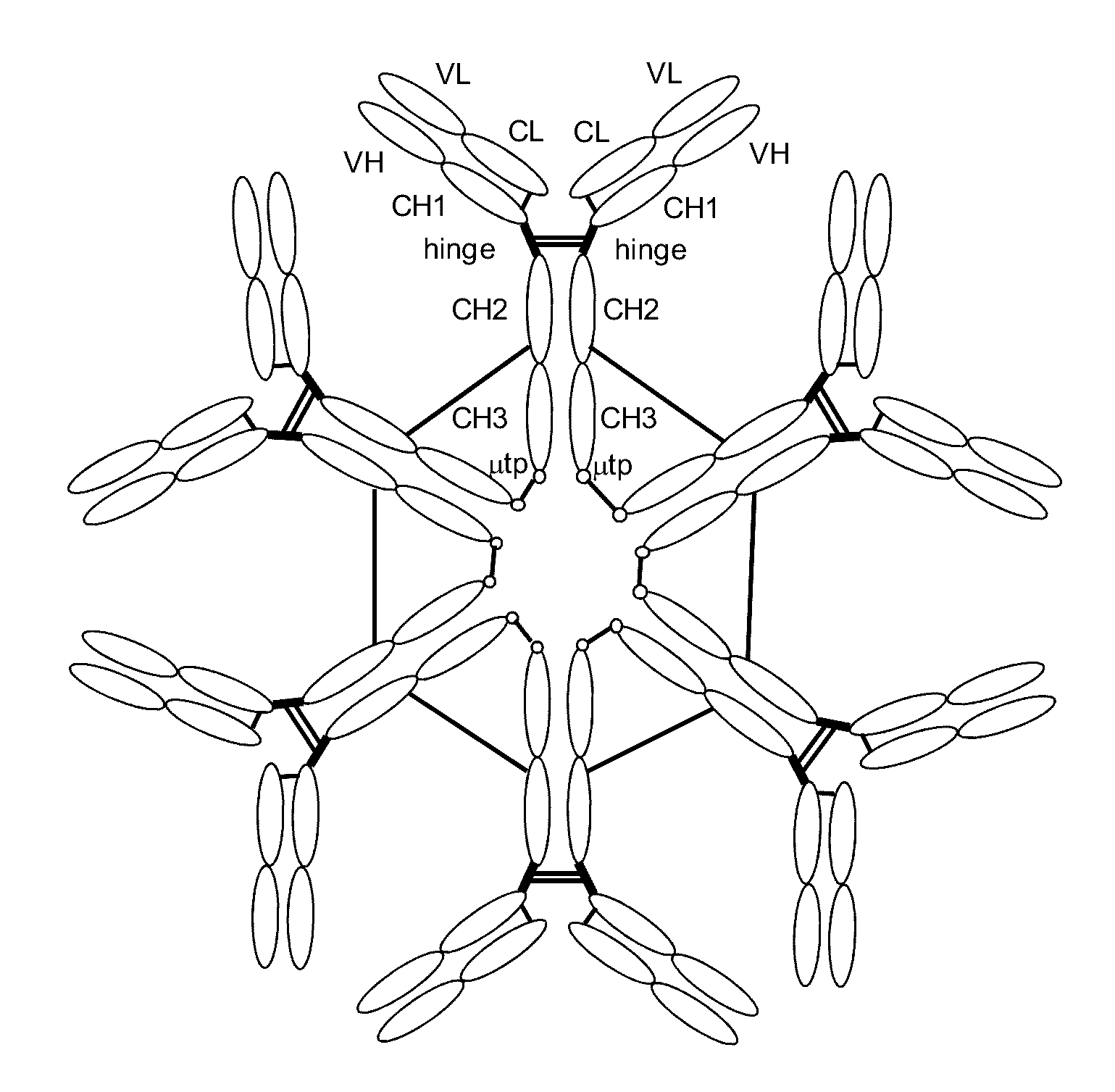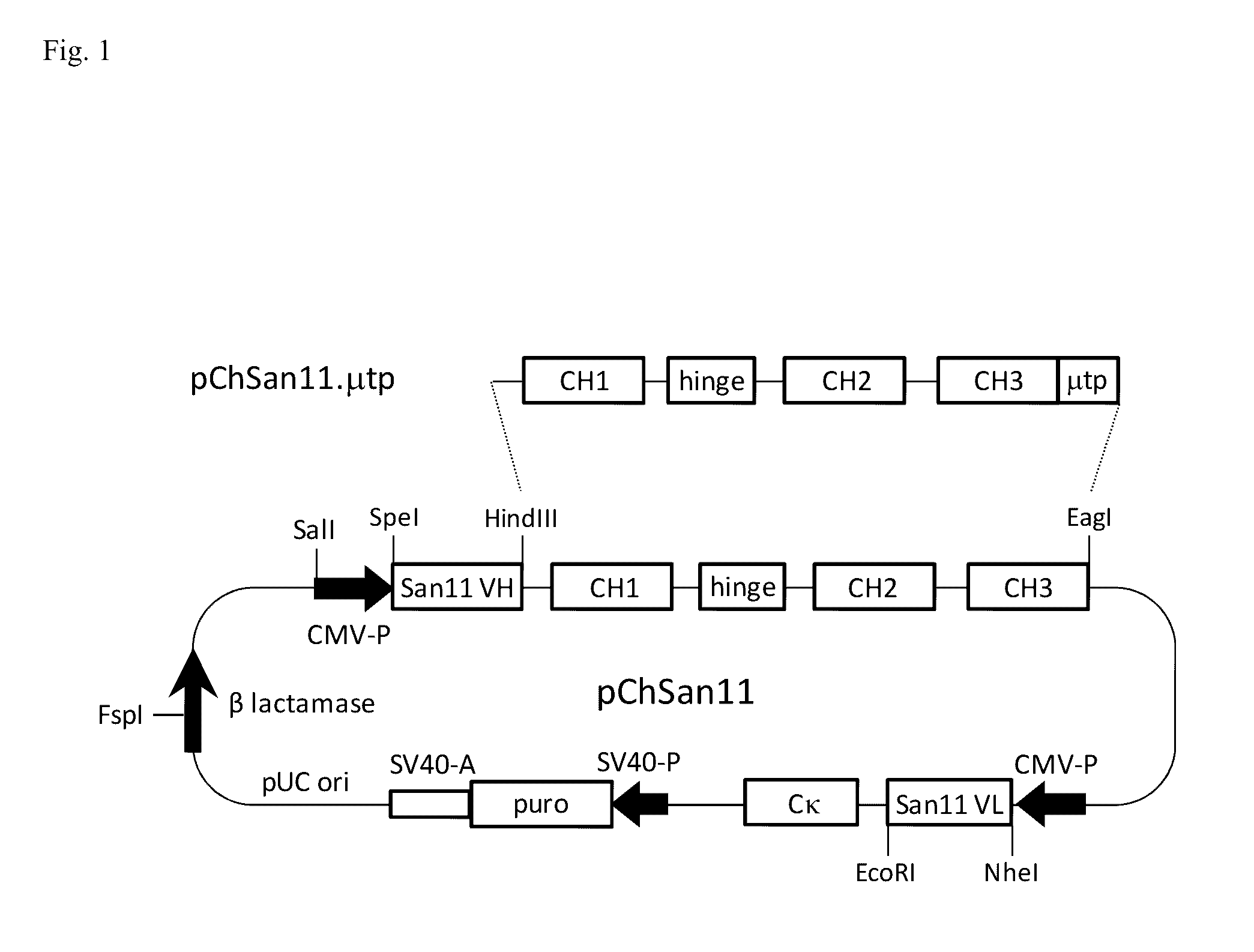Antibodies or fusion proteins multimerized via cysteine mutation and a mu tailpiece
a technology of antibodies or fusion proteins and cysteine mutation, which is applied in the field of b-type glycoproteins, can solve the problems of long serum half-life, 23 days, and slow clearance of igg antibodies
- Summary
- Abstract
- Description
- Claims
- Application Information
AI Technical Summary
Benefits of technology
Problems solved by technology
Method used
Image
Examples
example 1
Expression Vector for Chimeric Anti-Human CD30 Monoclonal IgG Antibody
[0139]Gene cloning, mutagenesis and plasmid construction in this work was carried out with standard molecular biology techniques such as those described in Sambrook and Russel (Molecular Cloning, A Laboratory Manual, 3rd ed., 2001, Cold Spring Harbor Laboratory Press, Cold Spring Harbor, N.Y.), Kostelny et al. (Int. J. Cancer 93:556-565, 2001), Cole et al. (J. Immunol. 159:3613-3621, 1997) and Tsurushita et al. (Methods 36:69-83, 2005).
[0140]The mammalian expression vector pChSan11 (FIG. 1) for production of a mouse-human chimeric IgG1 / kappa form of the mouse anti-human CD30 monoclonal antibody San11 (ChSan11) was constructed to contain the following genetic components. Proceeding clockwise from the SalI site of pChSan11 in FIG. 1, the plasmid contains the heavy chain transcription unit starting with the human cytomegalovirus (CMV) major immediate early promoter and enhancer (CMV-P in the figure) to initiate trans...
example 2
Fc Mutants that Form Multimeric IgG Antibodies
[0144]To generate Fc mutants that form multimeric IgG antibodies, a DNA fragment encoding the 18-amino-acid-long tail piece of human μ heavy chain (μtp; also called μ tailpiece) was first fused to the 3′ terminus of the gamma-1 heavy chain coding region in pChSan11 to generate pChSan11.μtp. The amino acid sequence of μtp is PTLYNVSLVMSDTAGTCY (SEQ ID NO:3). The amino acid sequence of the heavy chain constant region encoded in pChSan11.μtp is ASTKGPSVFPLAPSSKSTSGGTAALGCLVKDYFPEPVTVSWNSGALTSGVHTFPAVLQSS GLYSLSSVVTVPSSSLGTQTYICNVNHKPSNTKVDKKVEPKSCDKTHTCPPCPAPELLGG PSVFLFPPKPKDTLMISRTPEVTCVVVDVSHEDPEVKFNWYVDGVEVHNAKTKPREEQY NSTYRVVSVLTVLHQDWLNGKEYKCKVSNKALPAPIEKTISKAKGQPREPQVYTLPPSR DELTKNQVSLTCLVKGFYPSDIAVEWESNGQPENNYKTTPPVLDSDGSFFLYSKLTVDK SRWQQGNVFSCSVMHEALHNHYTQKSLSLSPGKPTLYNVSLVMSDTAGTCY (SEQ ID NO:4).
[0145]An amino acid substitution to Cys was then introduced by site-directed mutagenesis at each of positions 256, 279, 283, 284, 285, 28...
example 3
Expression and Purification of Anti-CD30 IgG Antibodies
[0150]The expression vector pChSan11 was introduced into the chromosome of a mouse myeloma cell line NS0 (European Collection of Animal Cell Cultures, Salisbury, Wiltshire, UK) to obtain a cell line stably producing ChSan11 IgG1 / kappa antibody. NS0 cells were grown in DME medium containing 10% FBS at 37° C. in a 7.5% CO2 incubator. Stable transfection into NS0 was carried out by electroporation as described in Bebbington et al. (Bio / Technology 10: 169-175, 1992). Before transfection, each expression vector was linearized using FspI. In a typical experiment, approximately 107 cells were transfected with 20 μg of linearized plasmid, suspended in DME medium containing 10% FBS, and plated into several 96-well plates. After 48 hr, selection media (DME medium containing 10% FBS, HT media supplement (Sigma, St. Louis, Mo.), 0.25 mg / ml xanthine and 1 μg / ml mycophenolic acid) was applied. Approximately 10 days after the initiation of sel...
PUM
| Property | Measurement | Unit |
|---|---|---|
| pH | aaaaa | aaaaa |
| pH | aaaaa | aaaaa |
| pH | aaaaa | aaaaa |
Abstract
Description
Claims
Application Information
 Login to View More
Login to View More - R&D
- Intellectual Property
- Life Sciences
- Materials
- Tech Scout
- Unparalleled Data Quality
- Higher Quality Content
- 60% Fewer Hallucinations
Browse by: Latest US Patents, China's latest patents, Technical Efficacy Thesaurus, Application Domain, Technology Topic, Popular Technical Reports.
© 2025 PatSnap. All rights reserved.Legal|Privacy policy|Modern Slavery Act Transparency Statement|Sitemap|About US| Contact US: help@patsnap.com



